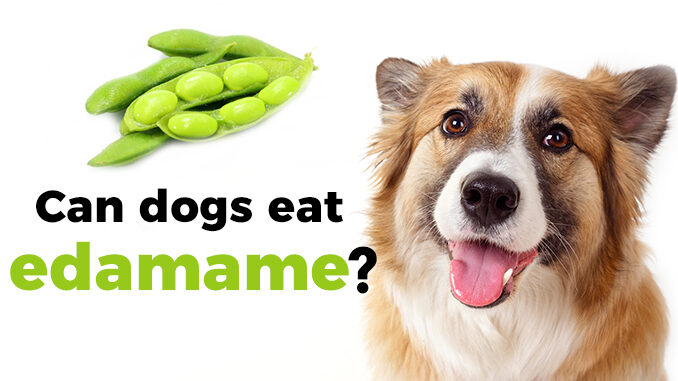
This article was updated on January 6th, 2023
Key highlight from our experts:
- Our veterinarian Dr. Joanna Woodnutt shares “Edamame beans are generally thought to be very safe for dogs, and they can make a good snack. “
- However, she also cautioned “Don’t forget to pod the beans just as you would for a human- the outer edamame bean shell is very fibrous and is more likely to upset your dog’s stomach.“
- Our dog nutritionist Dr. Bruno also recommended to “keep edamame or vegetable levels below 10% of your dog’s total daily food intake.“
- Keep reading to find out how to safely feed edamame to your dog.
Many people enjoy edamame beans as part of their diet. But is it also good for your dog or can it make your dog sick?
Is it a Good Idea to Give Edamame to a Dog?
Yes, dogs can eat edamame. Our veterinarian writer Dr. Joanna Woodnutt MRCVS confirmed: “Edamame beans are generally thought to be very safe for dogs, and they can make a good snack. As with all new foods, introduce edamame to your dog slowly, just one or two beans at first, and monitor for an upset stomach.”
3 Important Things to Know Before Feeding Your Dog Edamame
There are some risks and side effects you should know about before feeding your dog edamame.
- DO NOT give your dog the outer bean shells. Dr. Joanna Woodnutt stated: “Don’t forget to pod the beans just as you would for a human- the outer bean shell is very fibrous and is more likely to upset your dog’s stomach.”
- Soy is a common allergy with dogs: if you notice your dog is vomiting, having diarrhea, scratching or licking excessively, they might be allergic to soy. This is why we recommend discussing with your veterinarian before making any diet changes.
- If your dog is used to an all dry dog food diet and you mix in some edamame, you could find that you have a gassy dog on your hands. Bloating can become an issue if the dog eats too many beans at once.
To avoid having a dog with an upset stomach, Edamame also has to be prepared the right way.
Edamame Is Good For Your Dog… Only When Prepared the Right Way
If you have decided to make edamame part of your dog’s regular diet, it’s important that you know the best way to prepare them for consumption. First of all, not all edamame is good for your pet. Avoid offering your furry friend processed soybean snacks that contain sodium and other additives. Also, it is not recommended to feed your pet edamame that has been salted or cooked with spices or oils.
While humans eat edamame in various ways (raw, steamed, baked, boiled), the best way to offer them to your dog is steamed or raw (defrosted). Flavoured, fried, or baked edamame beans may contain too much salt and that could upset your dog’s stomach. Also, fried foods in general can cause pancreatic inflammation in dogs, which may lead to a visit to your vet. Baked edamame beans may also contain preservatives and oils that over time may lead to clogged arteries, so it’s best to keep them away from your pet.
Don’t forget to pod the beans just as you would for a human – the outer bean shell is very fibrous and is more likely to upset your dog’s stomach. If you have a small dog, there is always the risk of choking, so it’s best to offer them just the beans. Even if, initially, your dog doesn’t seem to have a problem with eating the pods, these might be difficult to digest, and they may end up with upset stomach and vomiting.
How Much Edamame Can your Dog Eat?
Since edamame is not toxic to dogs, you needn’t be afraid to feed them to your pet. They are a great low-calorie, high-protein snack that contains no fat and won’t cause weight gain. However, you should avoid offering your dog too much since a high amount of soy can cause stomach aches. One to five unsalted, out-of-shell beans is an ideal dog treat portion for your four-legged friend.
However, keep edamame or other veggies at less than 10% of your dog’s overall diet: Dr Kelsey Bruno, who holds a Ph.D. in Animal Science and is an instructor of animal nutrition, shared with Senior Tail Waggers that “It is recommended to keep vegetable levels below 10% of your dog’s total daily food intake. This is because dogs derive their primary nutrition needs from animal and other plant products, which they will get from their dog food. An excessive amount of edamame in your dog’s diet could lead to nutritional deficiencies.”
To keep their beneficial nutrients fresh longer, you can keep the edamame refrigerated or frozen.
Is Edamame The Best Vegetable to Give to Your Dog?
If you are looking for some delicious, healthy vegetables that you can introduce into your dog’s diet, edamame is one of the healthiest choices you could possibly make. This is an extremely healthy food in small amounts and your dog will probably love to chew these tasty beans as a snack.
Edamame is good for your dog to help maintain a healthy coat and help with dry flaky skin. It is also great at helping regular your dog’s digestive system.
Edamame beans are known to improve heart health, reduce blood sugar and decrease the risk of breast cancer. They are also an excellent source of dietary fiber and B vitamins (Learn more on WebMD).
Other healthy vegetable options include carrots or green beans – which will help your dog maintain a proper GI system and maintain a healthy weight.
Is it a good idea to give vegetables to dogs?
Vegetables are not necessary for a dog’s health, but they can be incredibly nutritious as they are full of protein and fiber and contain very few calories. They are also cholesterol free, which means that they can help prevent weight gain and heart disease in canines. Veterinarians agree that dogs can benefit from vegetables in their diet, as long as you offer them the right veggies and you make sure such treats don’t make up more than 10 percent of your dog’s diet.
Vegetables that are good or bad for your dog?
Edamame is a healthy and safe choice for your dog’s diet. Other dog-friendly vegetables are: spinach, broccoli, carrots, green beans, kale, cucumber, celery and sweet potatoes. At the same time, avoid giving your dog grapes, onion, garlic, peaches, plums and apricots, as they can be toxic to them.
| Good Vegetables/Fruits | Bad Vegetables/Fruits |
| Spinach | Avocado |
| Broccoli | Grapes |
| Carrots | Onion |
| Green beans | Garlic |
| Kale | Plums |
| Cucumber | Apricots |
| Celery | Peaches |
| Apples | Tomatoes |
| Bananas | Cherries |
| Oranges | Asparagus |
Learn more on AKC website: vegetables good for your dog.
Edamame is Good For Your Dog: Health Benefits for Dogs
Edamame is a popular snack in Japan, Korea and China, often served on the half shell and dipped in salt or soy sauce. These green soy beans with a crisp texture and nutty, sweet flavor are known to improve heart health, reduce blood sugar and decrease the risk of breast cancer. They are also known as a good source of dietary fiber and B vitamins such as thiamine and riboflavin.
A recent study indicates that due to the large amounts of vitamin K that are found in edamame, adding this vegetable into your diet could lead to increased bone density and decreased risk of osteoporosis. They also have essential minerals like copper, phosphorus, magnesium, manganese, iron, and zinc, as well as antioxidants that help reduce the risk for chronic disease and keep you young and healthy.
Edamame is a wonder food that can help keep your dog fit and healthy. Rich in a wide variety of minerals that promote strong bones and overall health, edamame beans are an excellent source of protein for dogs along with some good fiber. They also contain omega-3 acids and other nutrients that have a lot of health benefits for your furry friend, such as maintaining proper metabolism and digestion, reducing the risk for diabetes as they age, and keeping their skin and fur in excellent condition.
Conclusion
As a conclusion, edamame, or green soybeans, is one of the most nutritious and delicious vegetables around, and it can be a great addition to your dog’s diet, as long as you choose quality soybeans, you feed it in limited portions and you prepare them in a safe way for your pup.
And what dog doesn’t love a yummy snack? Just cut the bean from the pod, pop it in your pooch’s bowl, and watch him munch his way to health!
Disclaimer: This website's content is not a substitute for veterinary care. Always consult with your veterinarian for healthcare decisions. Read More.



Be the first to comment